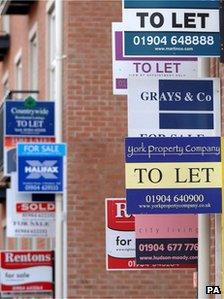Households renting from private landlords rises to 15% - ONS
- Published

More people now own their own home without a mortgage, the survey found
The proportion of people renting from private landlords in Britain rose from 10% to 15% between 2008 and 2011, the Office for National Statistics says.
found in that time the proportion owning a house with a mortgage fell from 40% to 35%.
In 1972 - just after the survey began - 37% of households had central heating. It had risen to 92% by 2000.
Other findings suggest the proportion of one-parent families tripled since 1971 but it has been steady since 1998.
While the number of people renting increased in 2011 to 15%, the proportion of people renting was usually nearer 20% in the 1970s.
The ONS said the housing market in Britain had suffered since the start of the recession in 2008, with a smaller percentage of new households successfully acquiring mortgages.
This is reflected in the decrease in the number of households owning with a mortgage and also in the increase in the number of households renting their accommodation, it said.
The proportion of households renting privately fell by almost two-thirds between 1971 (20%) and 1991 (7%), then remained between 9% and 11% until 2008.
'Smaller households'
The ONS said 7,960 households in Great Britain took part in its lifestyle survey for 2011, and it had conducted about 15,000 interviews with adults aged 16 or over.
The survey also found 92% of families with dependent children were headed by a married or cohabiting couple, compared with 78% in 2011.
The proportion of adults living alone almost doubled between 1973 and 2011, from 9% to 16%, while the average household size has become smaller over the 40 years between 1971 and 2011.
The proportion of women who have never married is 43%, up from 18% in 1979.
In 1971, the average household size was 2.91 persons and by 2011 the average size was 2.35 persons. The fall, said the ONS, was most rapid between 1971 and 1991.
It also said the fall in average household size was due to an increase in the proportion of one-person households, which almost doubled between 1971 and 1998 (rising from 17% of households in 1971 to 29% in 1998) and has remained similar since.
Other findings include:
Cigarette smoking fell from 45% in 1974 to 20% in 2011
The proportion of men and women drinking on five or more days a week fell from 23% of men in 1998 to 16% in 2011, and from 13% to 9% for women
In 1971, half of households had access to a car or van, in 2011 this had increased to three quarters
Since 1984, when the survey first asked about ownership of a home computer, the number of households with one increased from just over one in eight
The percentage of women working full-time who were members of their current employer's occupational pension scheme rose from 52% in 1987 to 60% in 2002. In 2011, 58% of women working full-time were members of their current employer's occupational pension scheme